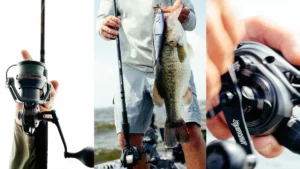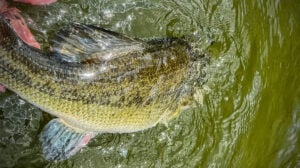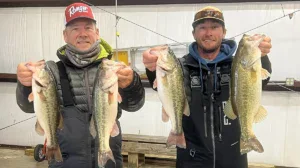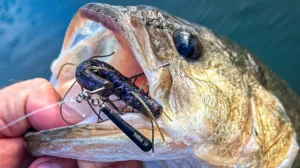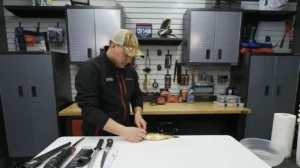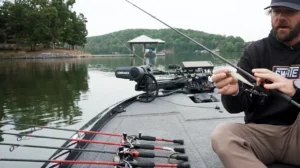The best fishing rods usually end up being the ones you use the most because they feel right and are the most versatile. Each angler’s preferences for a rod are a little different, based on their fishing styles, budget, size, age, etc. So one rod never fits everyone, but fortunately we have nearly an unlimited supply of fishing rod options out there.
There are certain things that will make one rod perform better than another. Often it boils down to the materials and processes used when building the blank. The quality of the components also go a long way toward how well a rod fishes. But it can also come down to brand, length, action, and even price. I have had excellent rods that were around $100, and others that cost significantly more that weren’t as good. So price doesn’t always indicate value.
So let us quickly rundown a few of the best bass fishing rods on the market, and the things we consider when evaluating them.
OUR PICKS FOR BEST FISHING RODS FOR 2025
- Best All-Purpose Fishing Rod – Level NGX Casting
- Best Fishing Rod Under $100 – FishUSA Flagship Bass Rod
- Best Fishing Rod for Big Swimbaits – iROD Quercus Swimbait Rod
- Best Spinning Rod – Trika 6X Spinning Rod
- Best Flipping Rod – G.Loomis GLX Flip and Pitch Rod
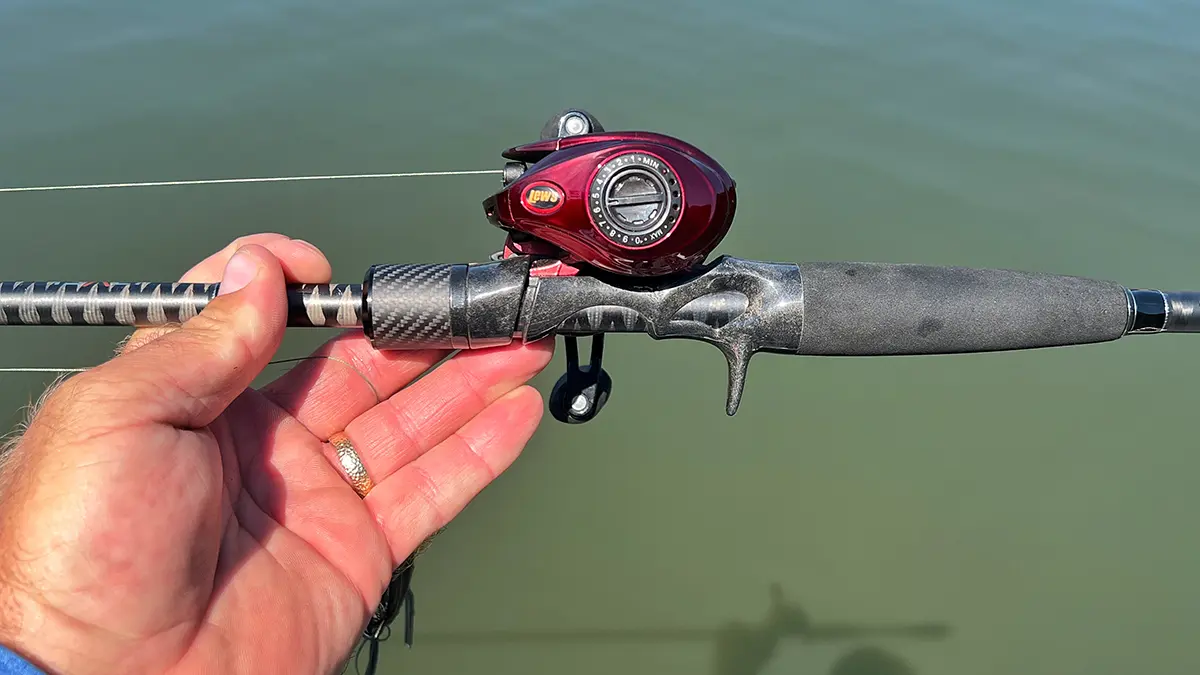
Level NGX Casting Rod
The Level NGX Casting rod is lightweight and solid, thanks to the Japanese Toray 30/40 Ton Carbon blank. The Carbon X-Wrap that runs all the way up the blank acts to reinforce it, while also adding a nice finish to the product. Level went with semi-micro Fuji K Frame Guides with Alconite Inserts — strong and sturdy as well. The main grip is a comfortable EVA foam, with a carbon rear grip and carbon reel seat. All three of these features further lighten the rod.
These rods are thinner diameter than some comparable rods and I really like that. It has a great feel in your hands and they have very nice tapers and actions. These are great all-purpose rods and each rod in the line-up can fish a lot of different applications. For more info, read our review of the Level NGX.

FISHUSA Flagship Bass Rods
In my opinion, the FishUSA Flagship bass rods are the best $99 rods on the market. This is partially because of their feel and actions and partially because of their sensitivity and aesthetics. They are light, sensitive and responsive. I can work a variety of baits efficiently. The backbone on these rods has held up to some very big bass this year, with the best one topping out at 7 pounds, 1 ounce. I have all of the rods in the line-up, and my favorite is probably the 6-foot, 10-inch medium-fast model. It’s a great jerkbait and topwater rod. But it’s also been fun with Senkos and even as a makeshift BFS rod for lighter baits like Ned rigs and small plastics like the Yamamoto Yamatanuki or Great Lakes Finesse Juvy Craw. The rods are well built, refined, and the grips are tacky and comfortable on long days on the water. For $99 you will struggle to find a better rod.
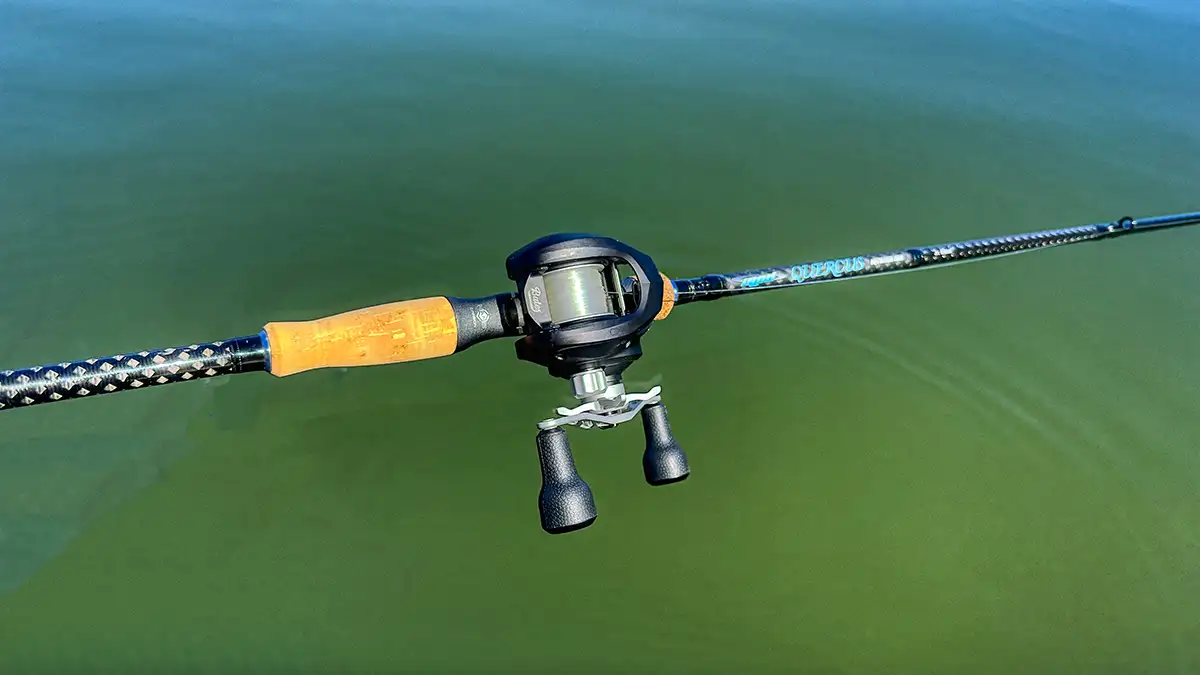
iROD Quercus Swimbait Rod
I have a ton of respect for iROD. Their rods are very well made and generally available for purchase without long wait times. And they are priced where most guys can afford to own one. The Quercus is their latest line and I love the Swim Jr rod. It can handle 1- to 4-ounce baits and is a 78H with a Mod Fast taper on the blank. This gives it some flex, which tends to keep treble hooks pegged.
I’ve been fishing a lot of gill baits and medium glides on it and love how this rod casts and fishes them. It has premium cork split grips, Fuji “0-Type” guides and ultra-light nano carbon reel seats — it’s a step up from their Genesis III rods in terms of components and aesthetics. And their 30 ton graphite blanks with carbon fiber-reinforced WXW wrapping make for strong but light swimbait rods.
I admit I’m biased as two of my biggest bass this year have come on this rod on big hard swimbaits. You can see one of them if you scroll down.

Trika 6X Spinning Rod
I have been using the Trika 6X Spinning Rod for a couple seasons and it is one of the finest spinning rods I’ve ever fished. Trika is a bit of a unique option in the industry. They sell direct to consumers so they are making rods that compare to the $400-$600 rods in the market but they are keeping their prices between $200-$300 by cutting out distributors and retailers. They use some of the best blanks and components available and their rods show it.
Trika has redefined sensitivity with the exceptional 6X lineup. What sets the Trika 6X apart is the EkkoChamber + Axial Weave technology — which results in a lighter and longer casting rod that amplifies vibrations, ensuring you feel every underwater movement with unmatched precision.
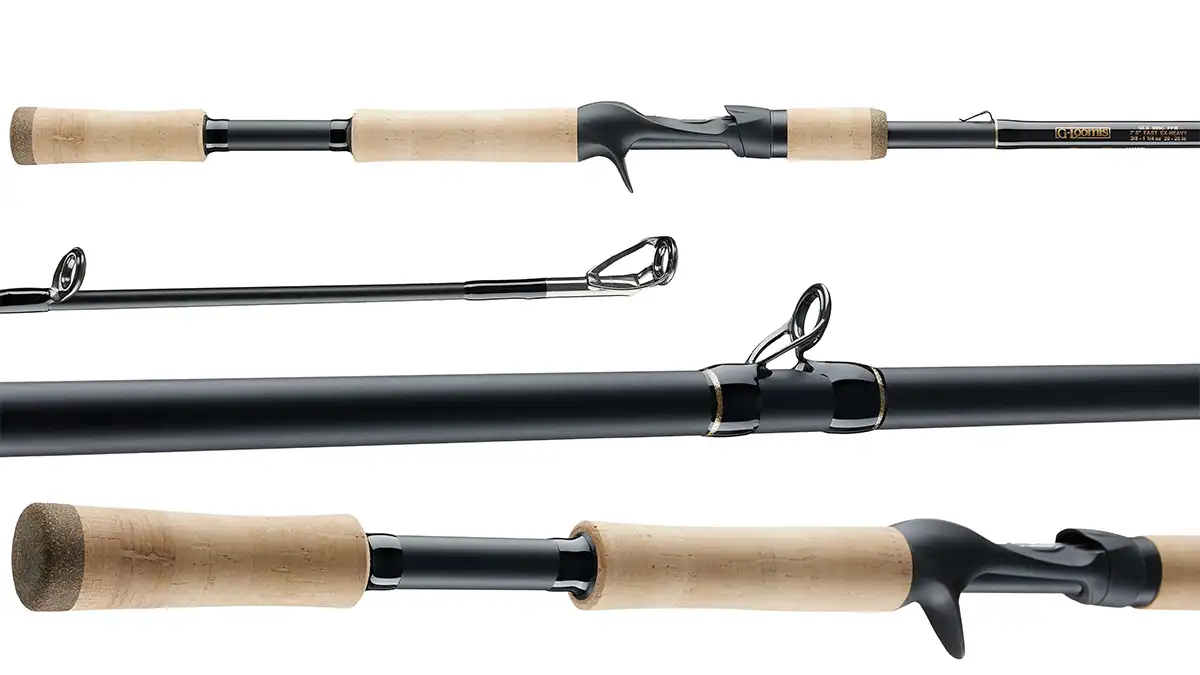
G. Loomis GLX Flip and Pitch Rod
G. Loomis GLX rods have historically been a staple among bass anglers in the know. For a long time, the GLX series were literally the best bass rods money could buy and they sold by the thousands. They went out of favor when the bass fishing rod market exploded with other options but happily G. Loomis has re-introduced this favorite back into the line-up with a full upgrade of technologies and features.
These rods are built with structural upgrades achieved through a proprietary blend of high-modulus graphite and advanced technologies. The engineers at G. Loomis carefully isolate and reinforce areas that are likely to fail under heavy load for maximum durability. Add in a lightweight and tangle-free Fuji K SiC guide train and premium split cork grip that enhances their already amazing sensitivity while making them some of the lightest flipping sticks on the market.
Best Fishing Rods by Technique
There are so many techniques for bass fishing alone that it makes it impossible to review all fishing rods in one piece. Because of that, we have several specific fishing rod guides to help anglers make good choices when it comes to matching a good rod to how they fish.
But here is a short rundown of some of the best rods in a few of the popular bass fishing rod categories.
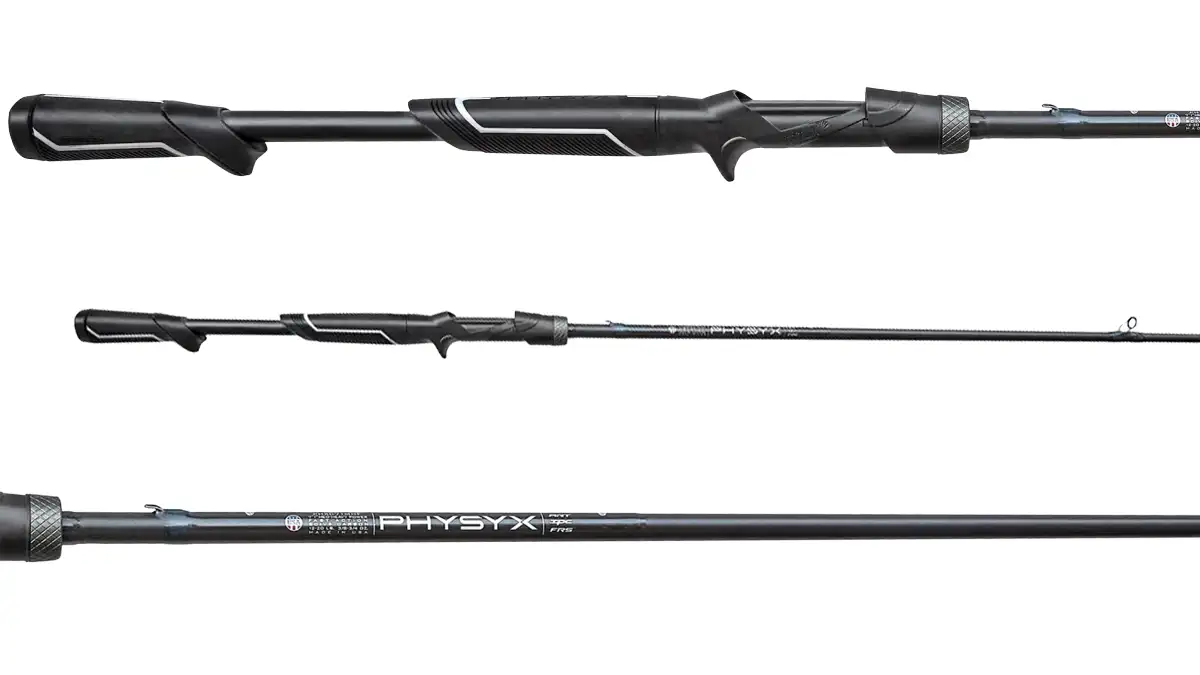
Best Spinnerbait / Chatterbait Rods
I think a good casting rod that can handle spinnerbaits, swim jigs, and ChatterBaits is one of most handy fishing rods for bass fishermen. I call it the “winding rod” because these are all baits that you just reel through shallow cover. So you need some finesse to direct your lure along a letdown or through some grass stalks, but you need some back bone to drive the hook home.
A 6-foot, 10-inch fishing rod is perfect for most anglers because you roll cast a lot with these fishing lures to specific targets and lanes. If you do more bomb casting with these baits where you fish, you might want a little more length on your rod.
This rod will match well with 15- to 17-pound fluorocarbon line or 30 to 40-pound braid, depending on what baits you will throw. It can also handle some light-duty frog or heavier topwaters as well.
Some guys like a medium action rod for spinnerbaits and ChatterBaits but a medium heavy rod gives you more control of the fish in tight quarters and around obstructions like laydowns, stumps, dock posts, etc.
Spinnerbait or Chatterbait Rods We Recommend:
- St. Croix PHYSYX 7’2″ MH MF (Best Overall)
- G.Loomis GCX Casting Rod 6’9″ Medium 812C SBR
- Team Lew’s Signature Series 7′ M F

Best Jig / Worm Rods
Every bass fisherman should own a sensitive and strong jig worm rod. This rod will have a good backbone with a little bit of tip action to accurately cast worms to cover or offshore targets. Most anglers will want a medium-heavy power with a fast action on this combo. A little more length will give you better casting properties and more ability to pick up line on a long cast for a strong hook set at distance.
A longer 7-foot to 7-foot, 4-inch rod usually suffices for this technique. Medium-heavy power gives you some flexibility with casting. If you want to step up to heavy it won’t cast as accurately but it could double as a flipping and pitching rod too.
A 12- to 20-pound line fluorocarbon line is best on this rod.
Jig / Worm Rods we Recommend:
- G. Loomis NRX+ Casting Rod 7′ Med Hvy JWR (Best Overall)
- St. Croix BassX Casting Rod 7’1″ Med Hvy/Fast
- Shimano Zodias 7’2″ Med Hvy / Fast
- Level NGX 7’2″ Med Hvy / Fast Casting Rod
Best Topwater Rods
Anglers should place a lot of emphasis on a solid topwater rod. This is one rod where it pays to have it be higher quality. A lot of the other rods you are just holding in one place, or just slowly lifting and lowering when you fish. But a good topwater rod needs to provide very precise casts with hard to throw lures. You spend all day working the rod with lots of jerks and pauses. So a heavy rod or one that is out of balance can make for a long day of uncomfortable fishing.
This is another place where a shorter rod can help because you are constantly jerking the rod down towards the water. A longer rod can get problematic. A shorter rod will generally respond quicker and be lighter.
A 6-foot, 8-inch to 7-foot rod fishes well for most anglers for topwaters. If you are going to throw bigger topwaters, a little longer rod with a bit more backbone might be better especially if used with braid.
This rod will generally employ 12- to 14-pound monofilament or 30-pound braid for topwater season.
We covered the best jerkbait rods in another piece, so here is our quick rundown of some of our favorite topwater rods.
Topwater Rods We Recommend:
- Shimano Expride B Cast Rod 6’10” Med Hvy (Best Overall)
- G. Loomis IMX Pro Cast Rod 6’8″ Med Topwater 802 TWR
- Fenwick Elite Bass Casting Rod 7′ Med Hvy

Best Crankbait Rods
Generally speaking, you will want a medium power rod with a moderate action to handle the wobble and pull of crankbaits with a lower gear-ratio reel paired with it. A 7-foot rod is a good starting place for an all-purpose crankbait rod. I will lean to a lighter medium-light power and shorter rod for small shallow crankbaits and a longer medium to medium-heavy power moderate action for bigger deep diving crankbaits. So a 7-foot medium is a good all-purpose, middle of the road stick.
This rod will load when a fish sucks in the bait and give you a split second of extra time for the bass to close their mouth and then load the rod to drive the hooks smoothly. You don’t have to set a hard, whip-crack hook set with these rods but rather just lean into the fish hard when it loads.
Normally this rod will have 10- to 12-pound fluorocarbon on it.
Crankbait Rods We Recommend:
- Abu Garcia Winch Casting Rod 6’8″ Med Light Mod
- 13 Fishing Meta Crankbait Rod 7’6″ Mod
- Lew’s KVD Composite Cranking Cast Rod 7′ Medium
For more, check out our in-depth look at the Best Crankbait Rods.

Best Big Rods for Flipping / Swimbaits
A good flipping rod starts at 7-foot and can go all the way to 8-foot lengths for flipping in grass. And a good swimbait rod starts at about 7-foot, 6-inch and goes to 8 foot or longer. I will say that most of of the time I am using a different rod for flipping than I am for throwing swimbaits.
But if you want to keep the budget to a minimum you can get by with a flipping rod that can handle 2-ounce baits. That works well for throwing stuff like big soft swimbaits on Owner Weighted Beast Hooks, pre-rigged soft swimbaits as well as big swimbaits like the Scottsboro Tackle swimbait on a 1-ounce head for fishing offshore.
And you can punch 1-ounce weights with small beaver baits through matted grass or pitch 3/8-ounce bullet weights with creature baits into bushes.
I like 20-25 pound fluorocarbon for flipping or a heavy braided line for flipping heavy grass. And I like a 20-pound fluorocarbon for bigger soft swimbaits and a 20-pound copolymer line for smaller hard swimbaits and glide baits.
For more, check out our in-depth look at the best swimbait rods.
Flipping / Swimbait Rods We Recommend:
- G.Loomis GLX Flip and Pitch Rod (Best Overall Flipping)
- iROD Quercus Swimbait Rod (Best Overall Swimbait)
- Lew’s Elite Series Casting Rod 7’4″ Heavy
- Shimano Zodias Casting Rod 7’4″ Xtra Hvy Plus

Best Spinning Rods for Finesse Fishing
The rod every angler should have, and maybe even start with, is a good spinning rod. You want a combo that can handle lighter finesse techniques like Ned rigs, Neko rigs, drop shots, wacky rigs, spy baits, small swimbaits and even cranking small finesse crankbaits like Shad Raps. And this rod can also catch crappie, walleye, panfish, catfish and more. So it’s a jack of all trades rod for freshwater fishing.
A medium-power rod with a fast action with a 7-foot length gets the job done for most people. And a 10- to 20-pound braided line, with a fluorocarbon leader serves almost all the purposes well.
Spinning Rods We Recommend:
- Trika 6X Spinning Rod 6’10” Med Ligh Ext Fast (Best Overall)
- Shimano Poison Adrena Spinning Rod 7′ Medium
- Megabass Orochi X10 Medusa 6’11” Light Ext Fast
- St. Croix PHYSYX 6’8″ Med Ext Fast
With these high-quality spinning rods you can feel the subtlest of bites and take care of almost all of the finesse fishing situations in bass fishing. You will have to play with some lines and reels to find your perfect setup. But these rods are some of the finest spinning rods ever made in my opinion. The quality of spinning rods right now is the best I’ve ever seen for sensitivity, ability to fish light lures, and still land large bass.

Types of Fishing Rods
Really there are two main types of conventional rods, which are spinning and casting. You also have specialty rods like fly rods, jigging rods which are similar to modern day cane poles, travel rods which can be multi-piece versions of spinning and casting rods, and more.
Spinning
Spinning rod setups are used with spinning reels. This arrangement has the reel underneath the rod so there is no need for a grip trigger. It’s just a straight handle with a locking foregrip to hold the reel in place. A Tennessee handle has two guides that allow you to place a reel where you feel most comfortable on the handle, and then you tape the reel in place with electrical tape. But for the most part, spinning rods incorporate a standard stem-holding reel seat that locks in place with a screw-locking fore nut or rear nut.
Casting
A casting rod is built with a trigger in the handle that is on the underside and the bait casting or spin cast reel sits on top of it. These rods are made to palm a baitcasting reel in your hand as you fish and the trigger is in place to keep your hand locked on and give you a little more leverage on a hookset. You push the thumb bar to let line out and cast. It takes some practice to learn to cast a baitcaster, but these types of setups have much wider applications because they can manage larger and various types of lines better than a spinning reel can. And you can build higher gear ratio reels with stronger drags generally speaking in baitcaster setups. You basically have a lot more options with baitcasting gear.
We have covered the best rods for crappie fishing already. And we intend to cover the best rods for walleye fishing and the best rods for catfishing. And eventually the best fly fishing rods. But considering largemouth bass is the most commonly chased freshwater game fish, and a good all-around bass rod can be used to fish for trout, crappie, catfish, walleye and more. This best fishing rod list will focus primarily around bass fishing.
What Matters in a Good Fishing Rod
Materials
Obviously some materials are just better than others. Higher modulus graphite, additional carbon fiber weaves, even the resin and clear coat can affect a rod’s performance, weight and balance. So higher quality materials to start generally yield a more sensitive rod with a more consistent action that won’t roll against its spline. I tend to like a middle of the road modulus for power techniques and a higher modulus material for more contact techniques.
Price
This is the main determining factor for some folks, but I often advise if the best rod is a little above your budget, just wait a bit and save for the better rod. In my experience, that higher quality rod will last you a decade if you take care of it. So you are investing in long-term use. And we all want to enjoy our time on the water. Don’t settle for the absolute cheapest gear that is always causing you problems and aggravation on your personal time away from work and stress.
But don’t mistake this advice and believe I won’t grab a $79 rod if it feels like it’s well made and has good action and sensitivity. I have had some dynamite rods under $100 over the years. But typically speaking, I’m staying away from the $29 rods on Amazon.
Length
Length can be personal but most of the time it’s functional. Now if you are doing something like say skipping a jig, then the length of the rod matters in that a rod that is too long for your height can make the technique and process a lot harder on you. That can lead to some long-term wear injuries like should and elbow tendonitis. So consider the technique when choosing your rod length.
I like a shorter rod for techniques where I am going to jerk the rod tip downward like a jerkbait or a topwater lure. So I often reach for a 6-foot, 10-inch rod instead of a 7-foot, 4-inch rod.
Same for throwing a big lure like a deep diving crankbait. I want a longer rod that loads the bait a lot better and gives me a lot more distance on a cast. And, conversely, you want a shorter rod when you are roll casting short casts into tight quarters
Action / Power
We went into depth on rod action and power in a previous article, but to briefly recap, match the rod’s action to the techniques you like to fish. I will give you a basic six-rod setup in the best rods section below to cover 90% of your fishing. But you want a little more backbone in rods you have to drive a single hook. And a little less in treble hook bait fishing rods. You want more action in a rod you have to work with your hand and arm and less action in a rod where you just straight reel your lure.
Brand
Brand is another one of those personal choices. But it can also be a functional when it comes to fishing rods because some brands have long storied histories of making good rods — like G. Loomis for example. So you know you are going to get a good rod just starting with a trusted brand. Same could be said for any product you buy.
But some brands also just fit certain anglers style of fishing. Maybe you have a thundering hook set and you require a brand that makes really heavy duty blanks — like Falcon for example. Or maybe you enjoy the more finesse-y and ultra-sensitive type rods and you might lean towards a boutique brand like Megabass.
So brand is always a consideration, but some new brands will really surprise you with their quality and lineups — like Ark and Sixgill for example.
Other Fishing Rod Questions and Answers
1 Piece vs 2 piece fishing rods?
It used to be that a one-piece rod was far superior to two-piece rod because you had issues with rigidity and the ferrels fraying and breaking over time. But today’s two-piece rods have improved greatly. Most of my two-piece rods are just as good as my one-piece rods, but with the added benefit of being able to travel with me in a car or plane a lot easier. But generally speaking, I opt for a 1-piece for most of my main core bass fishing rods for more durability and fluid performance throughout.
What length rod is best?
I think for bass fishing, a 7-foot rod is hard to beat. Bass are fast and vicious predators so they can move quickly to take a bait and introduce slack. A 7-foot rod can take up a lot of line and drive a solid hook set even at distance. Shorter rods can be a little more precise in tight quarters and a longer rod can get you a bit more distance, but 7 feet is a great place to rest for bass fishing rods.
What rod can catch the most different types of fish?
I think a 7-foot spinning rod in a medium or medium-light power and fast action can double duty as a great bass, crappie, trout, bluegill, walleye and even catfish rod. I wouldn’t want to fight a 30-pound blue or flathead on it. But it will catch you plenty of channel cats. A 7-foot medium spinning rod can do a lot. A medium-light rod can throw lighter baits for panfish better and is what I use most of the time for crappie fishing.
I also am a big advocate of bait finesse system rods now which uses lighter casting rods and bait casting reels geared specifically to throw light baits. I have caught bass, crappie, bluegill, stripers, white bass, yellow bass, shell crackers, catfish, drum and yellow perch on my bait finesse setups. While your tackle is usually on the smaller side, it’s a fun way to catch a lot of different fish species on small tackle.
Hopefully this round-up will help give you some ideas on rods for various bass fishing applications.

